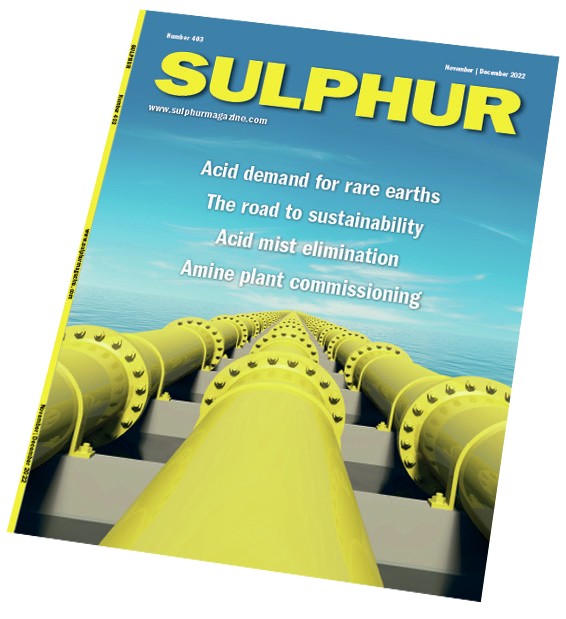Sulphur 403 Nov-Dec 2022

30 November 2022
Back on the rollercoaster

Sulphur markets suffered a correction in July-August that was more of a collapse; from $500/t to less than $100/t. Though it seems to have been something of an over-correction, and prices have moved back up since then, it is one of the most extreme price swings that sulphur has ever seen, comparable to the peak and precipitous fall in 2008. Indeed, at a time when commodity prices of all kinds have seen extremely high levels of volatility, sulphur has been more volatile still than just about all of them.
“For sulphur it probably means more volatility”
Many factors seem to have conspired to cause this. On the run-up, the war in Ukraine has obviously made export of sulphur from Russia much more difficult, though prices were climbing long before the war due to tight supply more generally. And on the fall, the decline seems to have been driven particularly by the phosphate industry, with prices falling rapidly in that sector a few weeks in advance of sulphur as demand failed to materialise. CRU estimates that world phosphate demand will see a fall of 9% in 2022 compared to 2021. Difficult planting weather has been a contributing factor, but high phosphate prices another – a knock-on effect of the gas crisis in Europe which has driven ammonia, one of the key inputs into MAP and DAP, to record price levels.
But underlying all of this is the slowdown in the Chinese economy. China has dominated every commodity market for the past two decades as its rapid industrialisation saw record growth. The covid pandemic and a heavy-handed response to it has certainly played its part, but, moreover, China is also now facing the kind of demographic cliff that Japan encountered in the 1980s and 90s. Coupled with over-building of capacity in just about every sector, and an often unheralded pivot towards cleaning up the environmental mess that the country’s industrialisation has caused, this has led to industries being forced to close, rapidly rising debt and a collapse in the real estate sector symbolised by the default and near collapse of property giant Evergrande; almost a Lehman moment for China. Climate change is also playing its part, with heatwave and drought shutting down hydroelectric power. Demographics and market saturation mean that China’s economy has been slowing for a decade, from the peak growth rates of 14% in the late 2000s to around 6% pre-covid. The covid years, with the 2020 freeze caused by lockdown and the resulting rebound in 2021 averaged 5.2% between them. But this year the forecast is somewhere less than 3%, and that spells trouble for all of us.
This year’s energy price crunch, a by-product of the Ukraine conflict, is already leading to recession in Europe, and though it is much better insulated by domestic production and consumer spending, there is a chance of it doing so in the US. A slowdown in China, the world’s factory, will only make things tougher. And for commodity markets it means some leaner years ahead before growth can take off again elsewhere. Lower industrial growth means less demand for copper and nickel, which have been major drivers of sulphuric acid production and consumption. Lower demand for oil and gas means less sulphur being recovered, and possibly explains OPEC+’s decision to tighten oil markets in October. For sulphur it probably means more volatility, as the timing of expansions and contractions in various producing and consuming markets are unlikely to be simultaneous. At CRU’s recent Sulphur and Sulphuric Acid Conference in The Hague, John Bryant of The Sulphur Institute advised sulphur buyers to get their supply chains in order, as there are undoubtedly choppy waters ahead, and it’s advice that might be well taken by all sectors of the commodity industries.






